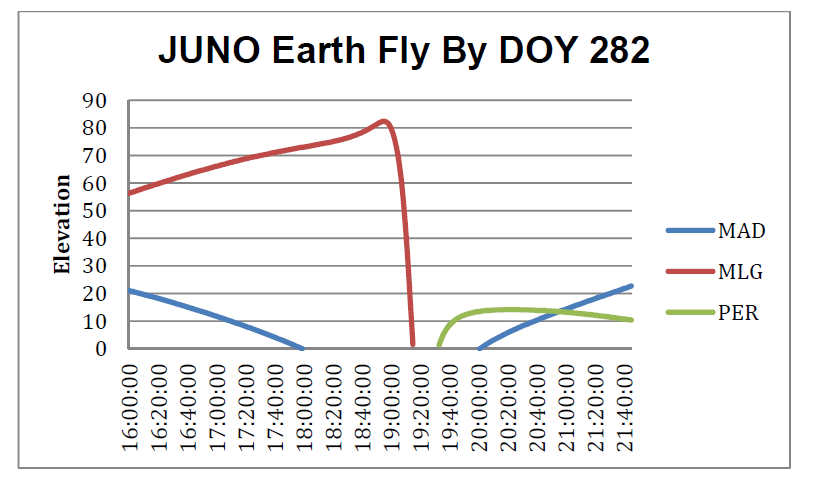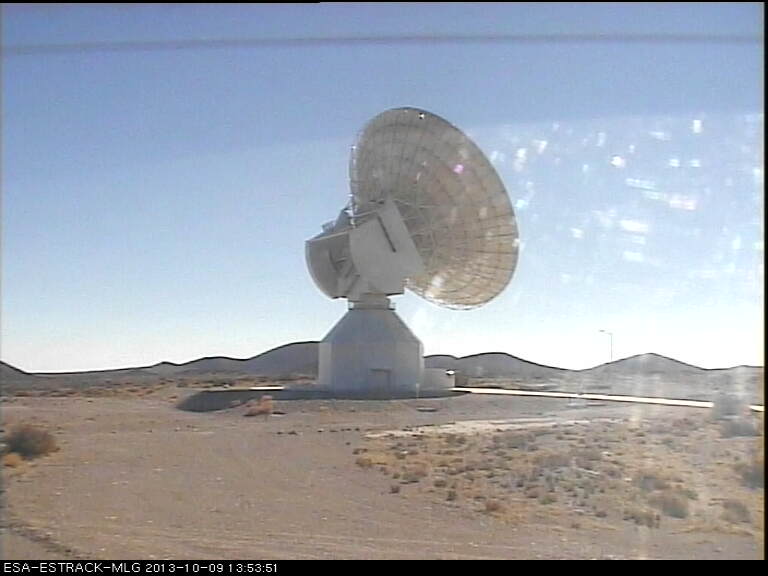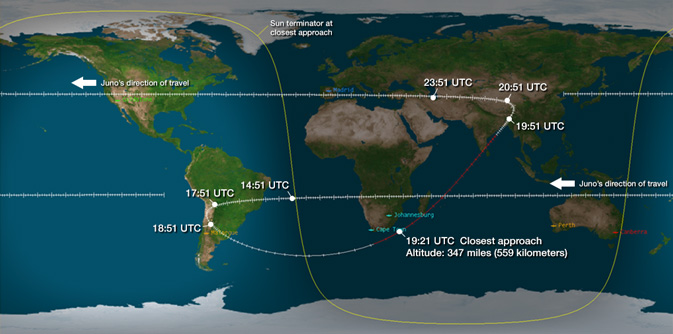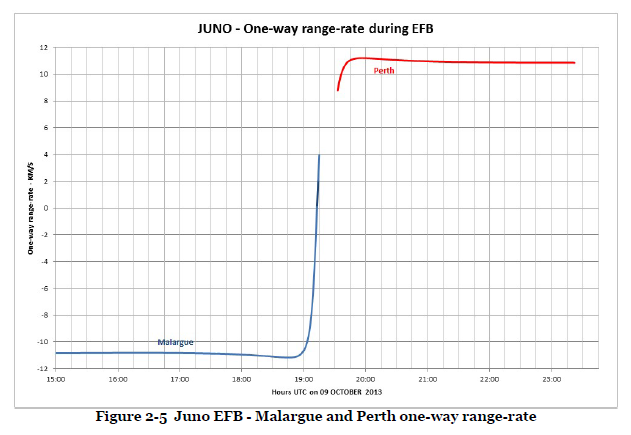This evening at 21:21 CEST, NASA’s Juno probe will whiz past Earth in a crucial gravity assist manoeuvre needed to fling it with sufficient speed to its destination: Jupiter, with arrival set for 2016.
The event will also mark another milestone in ESA/NASA cooperation, when two ESA ground stations track the probe, acquiring and recording radio signals that may help unravel the long-standing flyby anomaly, first detected in 1990.
If you haven’t yet, stop here and read the news report now live in the ESA website: ESA & NASA stumped by cosmic mystery
And Stuart Clark’s report in BBC Future, “Juno: The spacecraft putting sling theory to the test,” is well worth a read!
OK; now you know the basics. Here are the back-story details!
Tonight, engineers and the flight dynamics teams at ESOC will watch closely as the Agency’s new 35 m-diameter deep-space dish in Malargüe, Argentina, and a smaller 15 m dish in Perth, Australia, track Juno starting at about 16:00 UTC/18:00 CEST.
The service manager for the campaign is ESA’s Daniel Firre; he’ll be working in the Estrack Control Centre (a room, actually) located at ESOC, where he and colleagues will have a real-time view of the signals being received, first, via the Malargue 35m deep-space station (MLG) and later via the Perth 15m station (PER). The team at ESOC will be in voice-loop contact with Juno mission controllers at JPL.
The stations will record highly precise radio signal information – the Doppler data – that will indicate whether Juno speeds up or slows down more or less than predicted by current theories.
Daniel says that, while the involvement of the ESA tracking stations is obviously crucial, “This activity is very much led by ESA’s Flight Dynamics experts, who will be instrumental in processing the data once recorded by the stations.”
“This is not a straightforward exercise and more difficult than it was for Rosetta because Juno is rotating,” says Trevor Morley, from ESA’s Flight Dynamics team.
The data will be provided to NASA/JPL, who will be in the lead for detailed analysis and determination of whether and by how much the flyby anomaly is present.
I emailed earlier with NASA’s Susan C. Kurtik, based at JPL on the DSN team and serving as the Mission Support Manager for Juno. She wrote:
There is very little [information] about the mystery associated with this flyby, so this will be very popular. It is always wonderful to highlight the collaboration of NASA and ESA to advance science!
I can add that everyone at ESOC is pretty keen on this, too! 🙂
Summary – What’s happening tonight?
Juno, enroute to Jupiter, will perform a gravity assist Earth flyby (EFB) on 9 October 2013. Earth closest approach will occur around 19:22UTC with periapsis (closest point to Earth) located off the South African east coast at an altitude at just 561km.
The so-called ‘flyby-anomaly’ has been observed in the past with several other missions, leading to an anomalous acceleration of the spacecraft. The largest anomaly was recorded for NASA’s NEAR, whose velocity changed 13mm/second more than it should have. This excess is much larger than the expected errors in measurement. Attempts to explain this anomaly have not been conclusive and better observation of future flybys is required.
The ESA stations (Perth and Malargüe) will fill the gap in visibility of NASA DSN stations during the Juno EFB to try to observe this anomaly.

Estrack visibility of Juno flyby EFB – MLG (Malargue) station is in Argentina, PER (Perth) is in Australia. MAD is NASA’s DSN station near Madrid, Spain.
When is it happening?
ESA station tracking times will be:
- DSA 3 Malargue (35m) – Argentina
16:00-19:15 UTC - Estrack Perth (15m) – Australia
19:30-21:45 UTC
What will the ESA stations record?
Spacecraft telemetry, two-way Doppler and open-loop recording of the emitted radio signal.
Links
Mission Juno at SWRI
Mission Juno at SWRI – image gallery (taken from Juno during flyby – to be posted 10.10)
Say ‘Hi’ to Juno amateur radio event
Juno Careening to Earth for Critical Flyby Boost
Watch SLOOH Live
Since 2003 Slooh has connected land based telescopes to the internet for access by the broader public





Discussion: no comments